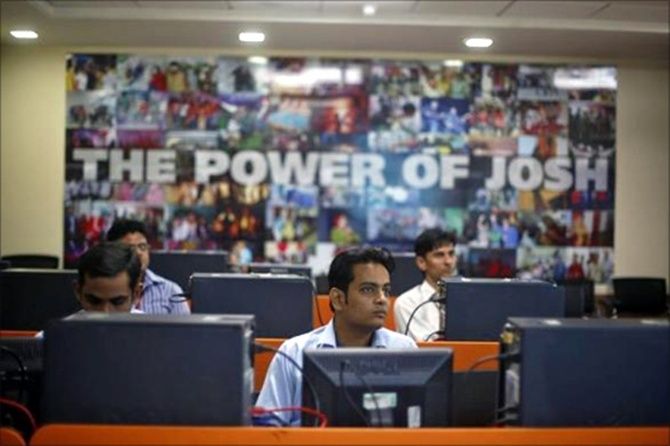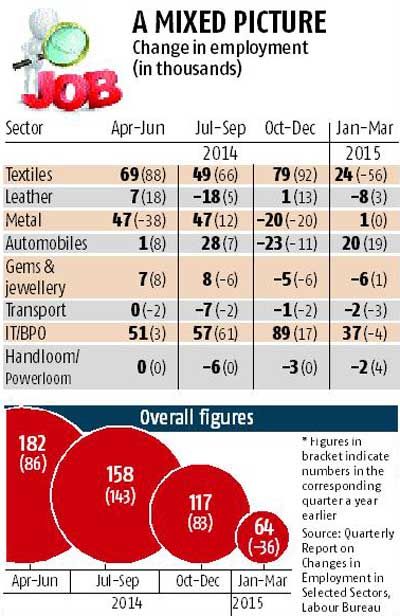From January-March this year, 64,000 jobs were created in eight crucial sectors of the economy.
 During the first year of the National Democratic Alliance government's term, job creation in India's manufacturing sector showed signs of stress.
During the first year of the National Democratic Alliance government's term, job creation in India's manufacturing sector showed signs of stress.
However, the situation seems better if the pace of employment generation is compared on an annual basis.
Sequentially, employment generation in most labour-intensive sectors slowed in 2014-15, showed the 25th Quarterly Report on Changes in Employment, released by the Labour Bureau.
Every quarter, the Chandigarh-based Labour Bureau conducts quarterly job surveys to gauge the impact of government policies on employment generation in the textiles, leather, metal, automobiles, gems and jewellery, transport, information technology (IT) and handloom sectors.
The latest estimates showed in January-March this year, 64,000 jobs were created in eight crucial sectors of the economy.
Though the number of new jobs was the lowest in four quarters, it rose sharply compared to the year-ago period, primarily driven by the IT sector. In the December quarter of 2014-15, 158,000 new jobs were generated, while in January-March last year, the number of jobs had decreased by 36,000.
On an annual basis, the number of jobs created in the textiles, leather, handlooms and transportation sectors was low.
There was a sharp cut in employment in the metals sector, which had shown signs of a job revival in the first two quarters of 2014-15. The gems & jewellery sector, too, lacked shine.

However, Prime Minister Narendra Modi's strong push to the IT sector led to a sharp rise in the number of jobs here.
For instance, in the March quarter of FY15, 37,000 new jobs were created in this sector, against a decline of 4,000 jobs in the year-ago period.
Economists say the growth in job creation hasn't kept pace with overall economic growth, as the corporate sector, particularly manufacturing, isn't producing more.
"Growth in the manufacturing sector has been really low in the past three years. If there is less production, there is a tendency to cut jobs or relieve labour," said Madan Sabnavis, chief economist, CARE Ratings.
Staffing firms said the government had been successful in creating jobs for the youth. "Sequentially, the numbers do not mean much, as companies follow a particular production cycle and employment is linked to that. However, the numbers are very encouraging on an annual basis, showing a bright future for jobs in the coming years," said Rituparna Chakraborty, president of the Indian Staffing Federation.
Most jobs created in the quarter ended March this year were contractual. Firms hired 49,000 contractual workers compared to only 15,000 full-timers.
This might point to a recovery, as direct employment had declined by 24,000 in the corresponding period last year.
In the March quarter this year, there was robust employment growth in export-oriented units, with 73,000 workers being hired, compared with job cuts of about 2,000 in the year-ago period.
Also, for units producing for the domestic market, the number of jobs decreased by 9,000, compared with a decline of 34,000 last year.
"This has come as a surprise. It looks as if the export sector was generating more jobs, preparing for the future. But I don't think this growth in jobs can be sustained," Sabnavis said.
"The government has to make easier laws to acquire land and bring in labour law flexibility to help industries grow. These changes, however, would take time," said Chakraborty.










